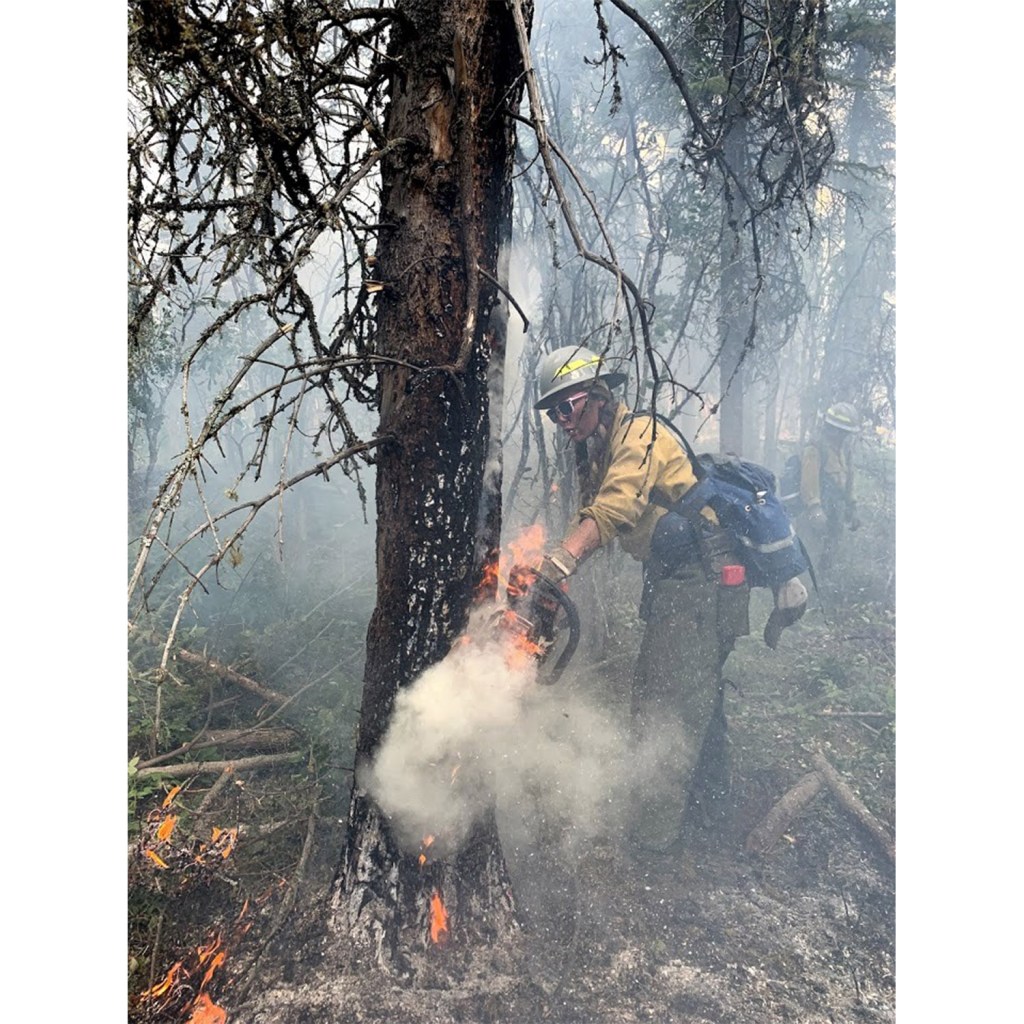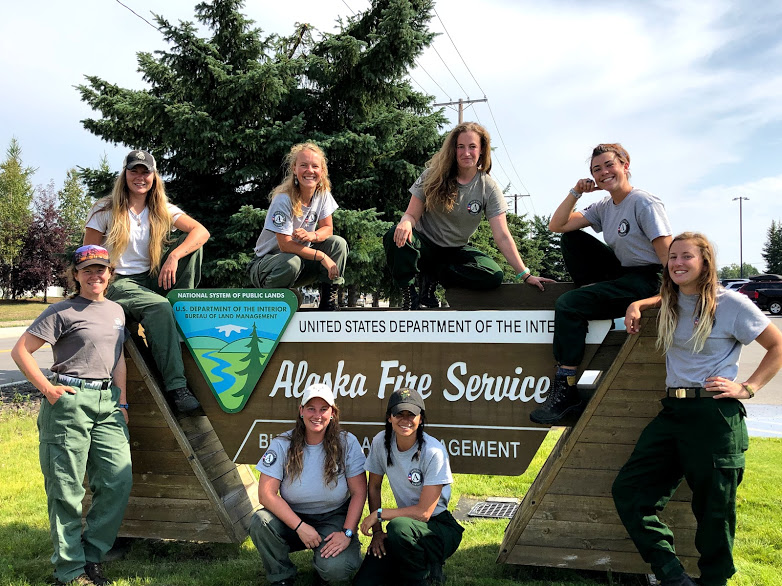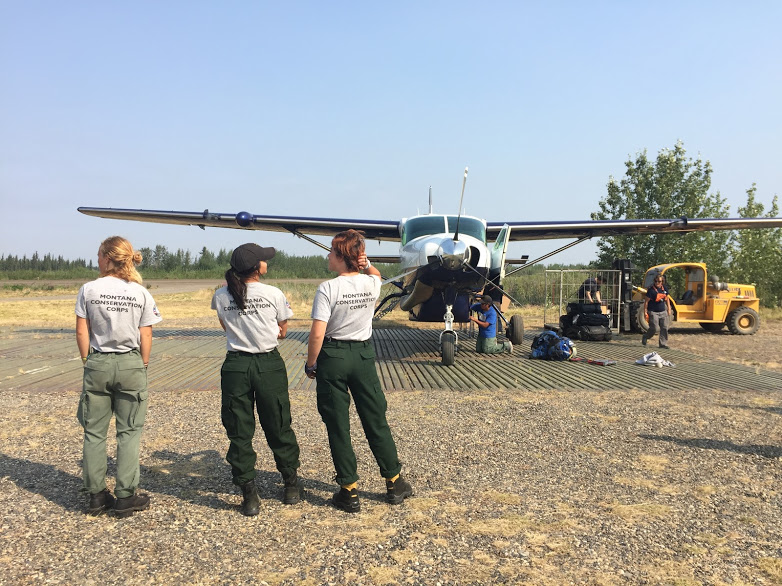While wildfire activity in much of the lower 48 was below average in July, Alaska has been burning. Fires have scorched more than 2.5 million acres since April 30, when the Oregon Lakes fire started and quickly grew to nearly 30,000 acres.
Teams of wildland firefighters from across the country converged on the northern state in July to help corral the flames—including one unique squad out of Bozeman, Montana. The Montana Conservation Corps’ Women’s Fire Crew, an innovative program that aims to close the significant gender gap in wildland firefighting with in-depth leadership and on-the-ground skills training, completed its first-ever wildfire assignment in what’s long been known as The Last Frontier.
A recent report from the National Fire Protection Association showed that only 7 percent of firefighters working in U.S. fire departments in 2017 were women. Although firefighters working for public agencies weren’t included in the analysis, the disparity is equally stark among wildland firefighters, said Sage Decker, fuels technician with the Bureau of Land Management’s Wind River/Bighorn Basin district in Wyoming, who helps run the Women’s Fire Crew.
While BLM Wyoming doesn’t have specific stats on wildland firefighters, the agency already knew there was a significant disparity. “While we’ve had women in fire for a long time, it’s always been low numbers, and we don’t seem to retain those women for moving up into management positions,” Decker said. In 2017, the agency took decisive action to address that gap, partnering with Montana Conservation Corps to create the Women’s Fire Crew program. Out of 28 participants over the last two years of the program, 20 have gone into wildland firefighting or related jobs like forestry.

A Women’s Fire Crew member puts technical chainsaw training to work. (Photo Courtesy: Montana Conservation Corps and the Bureau of Land Management Alaska)
Now in its third season, the 2019 Women’s Fire Crew consists of seven members and two crew leaders ranging from 22 to 28 years old, and hailing from every corner of the country. Anyone can apply, but the six-month program is designed for those with little to no experience who hope to break into wildland firefighting.
From May through October, MCC hosts the women at its Bozeman headquarters and offers leadership and communication training; education in firefighting and wildland fire behavior; technical skills certifications in chainsaws; and aid in job applications. MCC receives grants from AmeriCorps to fund its field crews, including the Women’s Fire Crew, and participants become AmeriCorps members once they’ve joined, which means they receive a living allowance for the duration and a monetary education award upon completion. BLM Wyoming provides the projects on public lands, where the crews train on the ground in habitat restoration, fuels mitigation, prescribed burns, and—potentially—a wildfire.
It’s not a guarantee that BLM Wyoming can get the Women’s Fire Crew out on a fire during the season. The 2017 crew was dispatched to California to aid in the massive firefighting efforts against the more than 9,000 wildfires that burned 1.2 million acres across the state. For two weeks, they fought the Orleans Complex fires in Six Rivers National Forest. But the 2018 crew didn’t see any assignments. The variance is simply a product of the BLM’s national ordering system for fire crews combined with timing, need and crew location. This season, as Alaska went up in flames, the agency sent the Women’s Fire Crew to join the more than 3,000 people fighting more than 200 simultaneous fires burning in July.
Although this fire season is worse than average for the state, it’s not record setting (6.6 million acres burned in 2004, followed by 5.1 million acres burned in 2015). But it is a record-setting summer for heat, with unseasonably warm temperatures across the region where most fires have been concentrated. Climatologists point to the situation in Alaska as a sign of the trend of longer and more devastating wildfire seasons.
“This is the fifteenth time in 80 years that Alaska has had 2 million acres burned,” said Beth Ipsen, public affairs specialist for BLM Alaska Fire Service. “Six of those occurred in the last 20 years.”
In July, the Women’s Fire Crew responded to the Hadweenzic River, where a 60,000-acre fire burned on the Upper Yukon in eastern Alaska less than 20 miles from Fort Yukon, threatened a few Native allotments and the Nashii Bible Camp eight miles to the west. Crew leader Shelby Descamps, 26, said that, paired with the weight of responsibility to protect those allotments and structures, her crew looked forward to the opportunity to put their training to work. They got the call from Decker on July 15, and after three days of travel by plane, boat and helicopter, they landed near the Hadweenzic. As they arrived, that fire was added to the Cornucopia Complex of 11 fires burning across more than 90,000 acres, threatening the Gwich’in village of Beaver at the western edge of the complex.

The 2019 Women’s Fire Crew arrived in Alaska July 18 to aid in fighting the 200+ fires burning across the state. (Photo Courtesy: Montana Conservation Corps and the Bureau of Land Management Alaska)
Over the next two weeks, the crew ran the gamut of operations available with their level of training. They cut a fireline up to 50 feet wide as a break to prevent the flames from progressing past that line and laid out hoses connected to pumps placed in the area’s ample natural water supplies in the event that the fire front reached the fireline. They accompanied a fire module, the crew usually dedicated to monitoring the fire, to examine weather forecasts and patterns and keep track of fire behavior on the front lines. They mopped up a spot fire, which involved cutting out a quarter acre of riparian growth and putting out flames. They also checked the area for hot spots with their bare hands and put those out with water and pulaskis.
While on the ground in Alaska, the crew met two other women who’d been part of the Women’s Fire Crew: one now on a hand crew, an entry-level crew that is deployed to the fire line, and one on a hotshot crew, a specialized crew sent into more intense areas with riskier fire behavior.
“I definitely believe and hope that it helps other women to see role models that they can maybe relate to fighting fires, as one of the bridges for closing the gender gap in careers like this,” Descamp said.
The program is unique in its curriculum and goal to give young women “the opportunity to receive training and work on habitat restoration and fuels reduction projects without the heavy burden of working against gendered expectations.” But the Women’s Fire Crew isn’t the only all-women fire crew in the U.S., and it isn’t the first. In 1971, when 20-year-old Caroline Peters applied to be a BLM forest firefighter in Alaska, Bob Krumm, the BLM Alaska Director at the time, told her that the agency couldn’t accommodate a woman on a crew as it was unreasonable to provide separate bedding and bathroom facilities. But, according to a July 2, 1971 article in All-Alaska Weekly, he said if she could gather the 12 women necessary for a whole crew, “he would be glad to launch an experiment whether women had the strength and endurance to do the job.” Peters returned with 24 women, and BLM hired them on to fight the Wickersham Dome fire that burned more than 15,000 acres near Fairbanks.

The crew traveled for three days by plane, helicopter and boat to reach the fires burning in eastern Alaska. (Photo Courtesy: Montana Conservation Corps and the Bureau of Land Management Alaska)
The misconception that women don’t possess the strength and endurance necessary for outdoor-sector activities or careers can be a major barrier to entry for women in these fields. Wildland firefighting carries an added barrier to entry in the fact that entry-level firefighting positions on hand crews require at least a baseline knowledge of technical tools, like chainsaw use and maintenance, to be competitive for the job. These are the kinds of barriers the Women’s Fire Crew model is designed to overcome.
“Alumni of this program have commented that they felt comfortable enough with basic skills that they could walk onto a fire crew and weren’t two steps behind; they didn’t feel like they were having to prove themselves and having to learn skills at the same time,” said Chris Nesset, regional director of MCC who runs the program in partnership with BLM Wyoming.
The Women’s Fire Crew is back in Bozeman now. For the remainder of the season, the crew will work on restoration projects and some prescribed burns in Wyoming, and then apply for jobs with the BLM in the fall. Of this year’s participants, Descamps says some want to apply for hand crews, and some want to build up to joining a hotshot crew. Descamps is aiming to apply to be part of a fire module.
And as other states express interest in starting up their own similar programs, says Decker, this is just the beginning of closing the gender gap in wildland firefighting.
Editor’s note: Montana Conservation Corps has been a nonprofit partner of REI since 2004. REI contributions totaling $140,800 have helped support the organization’s efforts over the years.


